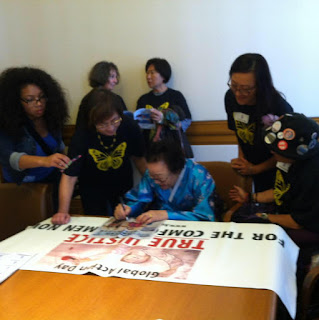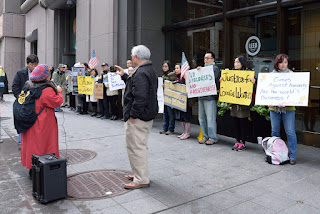Eclipse Rising
US-Based Zainichi Coreans for Decolonization,
Reunification and Zainichi Community Development
On December 28, 2015, the Republic of Korea (South Korea)
and Japan jointly announced that they had reached a “final and irreversible”
settlement agreement on the long-standing issue of the Korean “Comfort Women.”
The “Comfort Women” system (1932-1945), or Japanese military sexual slavery,
was a widespread and systematic racist, colonial violence against women. Its
central feature was the rationalized procurement, imprisonment, rape, abuse,
torture, and brutalization of an estimated 200,000 women and girls. One of the
largest organized systems of exploiting and trafficking of women in the 20th
century, the violence resulted in mutilation, death, or eventual suicide
of victims.
This latest so-called agreement is nothing more than
Japan’s attempt at permanent erasure of an extraordinary human rights atrocity
that continued for over a decade with impunity. As such, it amounts to an
unjust silencing of the victims and their principled demands for apology and
atonement, and turns its back on the fundamental understanding of women’s
rights as human rights.
Eclipse Rising stands in solidarity with the victims in
rejecting the “agreement” for its failure to restore their dignity and human
rights. While this “agreement” was ostensibly hailed as settling the “Comfort
Women” issue, none of the victims were consulted. In fact, it leaves out other
“Comfort Women” from other parts of Asia: 11 countries in all. It also
prohibits South Korea from ever raising the issue in any other international
body, including the United Nations, leaving Korean victims without a
governmental advocate.
Despite the gravity of the offenses, no actual written
agreement was ever produced; rather, the two governments issued separate
national statements summarizing the negotiations. Furthermore, in this
“agreement,” Japan refused to accept the term “coercion” to describe the
“Comfort Women” system, constituting a dubious regression from the 1993 Kono
Statement (made by then-Chief Cabinet Secretary Yohei Kono that acknowledged
Japan’s role in the coercion of girls in the “Comfort Women” system).
Despite the fact that the Allied Forces had full knowledge
about the existence of this heinous institution, the United States, Japan, and
South Korea colluded to silence and erase this history for over forty years
since World War II. Under escalating militarization and wars in post-WWII Asia,
US military presence and bases grew. Doubly victimized, many former “Comfort
Women” continued to suffer sexual exploitation in camp town prostitution long
after they were “freed” from Japanese sexual slavery.
Indeed, survivors had been
forgotten and abandoned by local, national, and international communities for
too long. This is the backdrop to the impassioned indignation displayed by a
former “Comfort Woman” Lee Yongsoo halmoni, as she learned of the news
and confronted the Korean Vice Foreign Minister: “Why are you trying to kill
us twice?”
We deny the assertion by the governments of the United
States, South Korea, and Japan that this so-called agreement is a step in the
“right direction.” To the contrary, we assert that it takes us several steps
backwards. The settlement cannot be said to be official government action, as
it lacks either cabinet approval or parliamentary endorsement in either the
Korean or Japanese legislatures.
We note, also, that to date, the Japanese legislature has
never passed a resolution of acknowledging state responsibility for the
“Comfort Women” system or other atrocities committed by the Japanese military
during WWII. Thus, this and all prior statements remain subject to
equivocation.
Japan’s payment of $8.3 million into a settlement fund is
widely recognized as compensation to the victims. Is it not then peculiar that
Foreign Minister Kishida has repeatedly claimed this payment does not at all
constitute “reparation,” but rather, a part of “a Korea-Japan joint venture”?
Thus, he rejects any suggestion that Japan admits culpability. Billed as
“humanitarian support,” this payment constitutes mere charity and hush money
from the Japanese government.
The “final and irrevocable” nature of this settlement also
leaves out any requirement on the part of Japan for ongoing documentation and
education of Japan’s responsibility for the “Comfort Women” system. In fact,
Prime Minister Abe has led the way towards denial and erasure of not only the
victims but the facts of history inconvenient for its PR objective to “improve
Japan’s image.”
In 2015, Japan tripled its public relations budget to $500
million, part of which is dedicated to an elaborate global campaign to deny or
dilute its role in WWII, most aggressively with regard to the “Comfort Women”
system, and other atrocities, such as the Nanjing Massacre. In fact, the latest
history textbook omits such facts, while glorifying its militaristic past. Such
history education renders a whole post-WWII generation of Japanese citizens vulnerable
to national amnesia, if not denial, about Japan’s own history. The Japanese
government’s demand to remove the “Comfort Women” memorial erected near the
Japanese Embassy in Seoul undermines any belief that Japan has engaged
earnestly and in good faith, as is expected in diplomatic negotiations.
Furthermore, this “agreement” runs counter to the 2014
Recommendations to the United Nations Human Rights Bodies on the Issue of
Japan’s Military Sexual Slavery (Comfort Women). Various UN treaty bodies,
including the Committee on the Elimination of Discrimination Against Women
(CEDAW), as well as the UN’s High Commissioner for Human Rights, have
repeatedly urged Japan to make reparations to the victims, officially
acknowledge legal liability, conduct investigations and prosecutions of those
responsible, and educate the public about the atrocities — so that it is not
repeated again. And yet, this “final and irrevocable” settlement does absolutely
none of these things. Rather, it permanently banishes the very existence of the
victims and their principled demands into an irrelevant past where they are
forgotten and abandoned — again.
The UN Special Rapporteur on Systematic Rape, Sexual
Slavery and Slavery-like Practices During Armed Conflict has established that
in totality, the “Comfort Women” system constitutes crime against humanity, to
which statutory limitations do not apply, and that Japan does indeed bear legal
liability. Navi Pillay, former High Commissioner for Human Rights at the United
Nations has stated that this “is a current issue, as human rights violations
against these women continue to occur as long as their rights to justice and
reparation are not realized.”
Thus, we must urgently take collective action to resist
and condemn this historical erasure and denialism masquerading as a just,
permanent, solution. As the first city in the country to ratify CEDAW, and as
people of conscience, we call upon all San Franciscans to stand with the
grandmothers, and build upon the unanimously passed Comfort Women Memorial
Resolution here in San Francisco — and urgently support the building of the
Comfort Women Memorial.
Eclipse Rising will not relent in seeking justice for all
“Comfort Women” through education and memorialization so that we can one day
create a world in which the fundamental rights of all girls and women take
primacy over political expediency, national interests and regional “security”
— and eliminate the use of rape and
violence against women as a central strategy of war.
We honor the grandmothers for galvanizing a global
movement against military sexual violence, and making a tremendous contribution
to the establishment of this violence as a crime against humanity. Their
efforts have helped overturn one of the most widely-accepted, unjust “norms” of
humankind, and leave all women and girls a legacy of hope.
January 08, 2016
eclipserising@gmail.com










